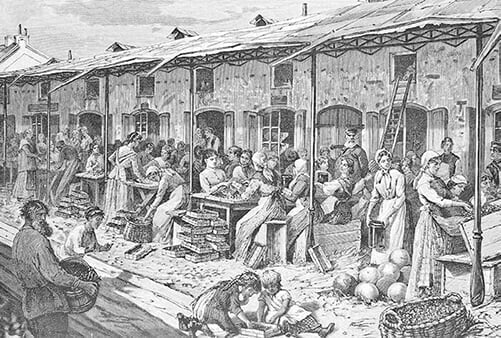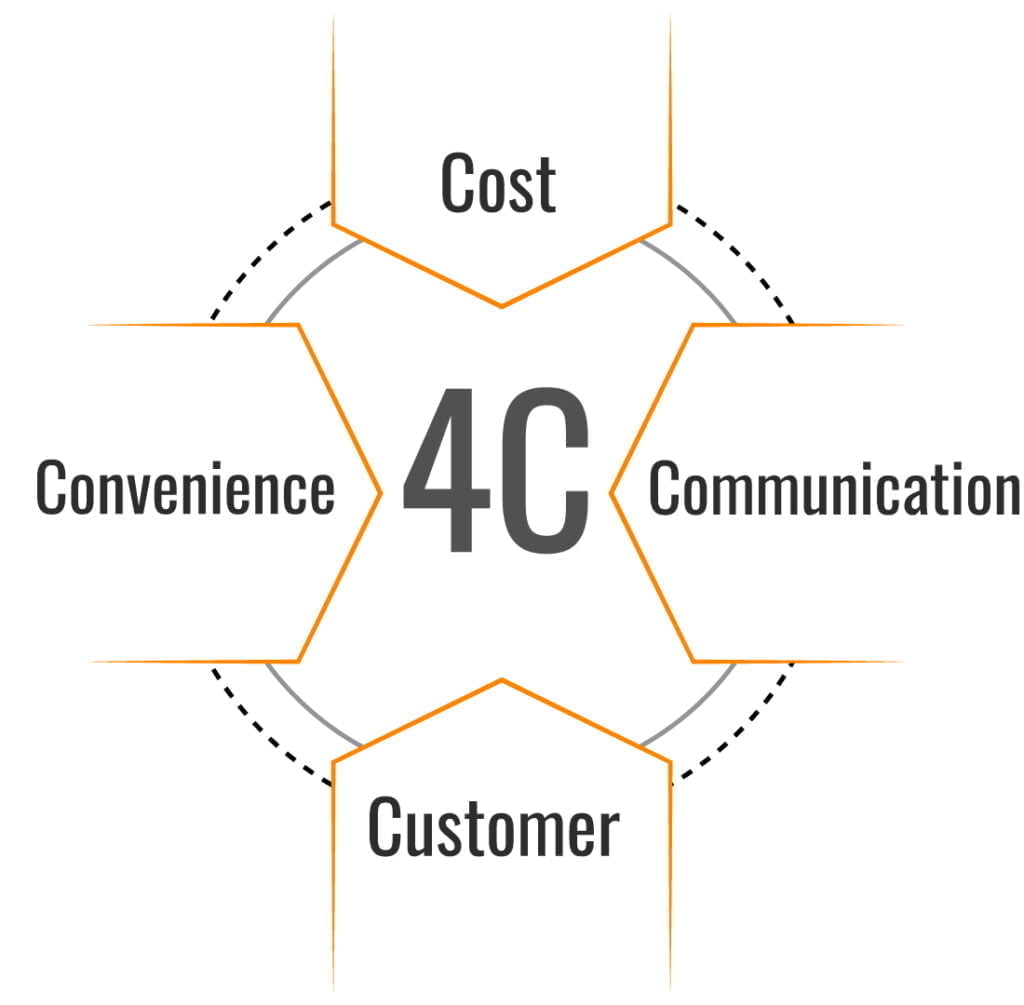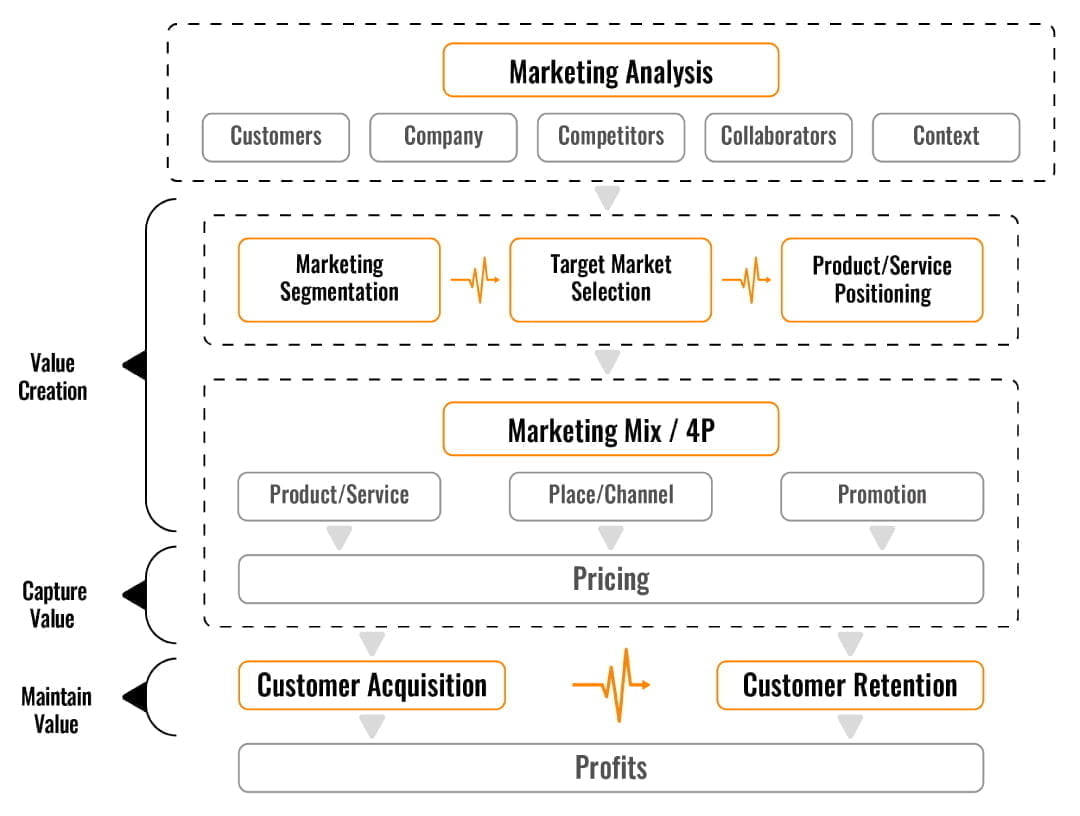Many people mistakenly think that marketing starts after a good or service has been produced. The concept of marketing includes processes such as sales and promotion (advertising), but also includes a much wider process. Determining consumer needs and creating products / services for these needs is included in this process. In addition, basic elements such as distribution and pricing are also a part of marketing.
Marketing is generally all of the plans that include the production, distribution, pricing, promotion and feedback process of the product or service designed to meet individual or social needs. These activities are expected to protect the interests of both the organization and the targeted audience and meet their needs. This expectation is handled in the same way in for-profit organizations and non-profit organizations (foundations, associations, etc.).
The proposition of meeting unlimited needs with limited resources constitutes the main idea of both the economy and marketing. The human needs that led to the emergence of marketing are unlimited. Marketing activities are continued with both digital tools and traditional methods. People choose the products they are most satisfied with to meet their needs. These choices make up the market for the products.
History of Marketing
Marketing basically begins with the seller selling the product he possessed to the buyer. It is shaped by the factors of development and change, but it is very different from the starting point today. In the beginning of the shopping period, the aim was to sell only the current product to the buyer. However, this expectation took on different dimensions over time. Eventually, the product that was sold because it was produced was replaced by the manufactured product because it was sold.

When the product did not have sufficient sales share, the principle of producing products with a high sales share emerged. Therefore, when the process shifted from “production first” to “market research first”, the first comprehensive foundation of marketing was laid.
After determining the basis of production, the problem to be solved was the “sales” factor. As production increased, so did the amount of products to be sold. At this point, important changes occurred in the marketing philosophy. Companies were no longer just interested in production, they were realizing that marketing and sales networks should also be managed.
Increasing competition and strong buyer market made the concept of customers come to the fore. The “customer-oriented” element steered all activities by participating in marketing. This change, where marketing gained its true meaning, enabled companies to maintain this relationship by establishing relationships with their customers.
4Ps of Marketing
After marketing activities focused on the consumer, the necessity to manage this process led to the formation of a professional group called marketer, marketing specialist and manager. Marketers first select the target market and then direct their activities to meet the needs of this target segment profitably. These activities are generally divided into four main topics; product, price, place and promotion. These activities, called the 4Ps of marketing, are the mix of marketing.
Since 4P are variables that marketers can use in different combinations to create value for customers, it is tailored to suit the needs and preferences of the target market. The concept of 4P, which was put forward by E. Jerome McCarthy, was disseminated and elaborated by Philip Kotler, and constitutes the understandable and applicable basis of today’s activities.
- Product: It is decided which product or service will be offered to which consumer. All activities such as brand name, logo, labels, customer service are gathered under the product title.
- Price: It is the process of determining profitable and suitable prices for the product to be produced by conducting market research.
- Place: Ensuring that products are sold in the right place at the right time is one of the important steps. Sales areas planned according to the customer ratio must have the amount of product to meet the demand.
- Promotion: Promotion strategies are developed in order to establish the correct communication with the targeted customer group and to create the awareness.

4Cs of Marketing
Another concept that defines marketing activities is the 4C element. 4C is more inclusive and detailed. The 4P strategy explain itself in terms of the producer, but 4C is in a more consumer-based orientation.
- Consumer: Considering the needs and desires of the consumer, the product should be determined and market research should be done.
- Cost: The cost does not only include pricing variables. It also includes the calculation of all the costs that the consumer spends in the stages of owning the product.
- Communication: A clear and easy way of communication between the consumer and the producer should be developed. And rapid feedback should be provided.
- Convenience: Different factors such as the location of the product and the type of sale should be calculated. Also should be presented to the consumer in the most appropriate form.

Segmentation
While developing marketing strategies, many different variables such as target market, target audience and product are taken into consideration. Not every product appeals to every consumer, and not every consumer is found in every environment. For this reason, marketers try to reach the right audience through the right market by segmenting their goals.
The most important point in segmentation is that the target market is the right market for the product. Consumers targeted by a segment are expected to have more similar characteristics than the large consumer base in the market. In addition, analyzing the behaviors of the targeted consumer audience is of great importance for an accurate segmentation.
The identified segments should be accessible to the brand and demanding for the product.
A properly segmented group of consumers cannot be sold a product they do not need. Let’s also assume that there is a consumer group in an undeliverable region. Even if this group is targeted with a properly segmentation, the strategy cannot be successful.
Persona
Persona is a fictional character that has the characteristics of the target audience. The persona is a representation of the potential consumer the brand is targeting. Persona enables marketing strategies to be based on more concrete features. The target audience is determined and their common characteristics, consumption behaviors, desires, expectations and habits are analyzed. Strategic planning is made according to this character by creating a representative character in the resulting analysis results.
It is not possible to have a successful strategy without determining the characteristics of potential customers correctly. The habits and expectations of the target audience are the primary determinants of the current and future marketing processes. For this reason, the created personas are an important factor in ensuring the success of strategies targeting potential customers.
Marketing Types
B2B Marketing (Business to Business)
B2B marketing is a type of marketing used for cross-company product or service sales. Brands that sell their products or services to another company carry out activities aimed at target companies.
B2C Marketing (Business to Customer)
The target audience of B2C marketing is marketing activities that are direct consumers. Brands market directly to them in order to deliver their products or services to their target customers.
B2P Marketing (Business to Person)
B2P marketing is the activities that enable sales by personalizing the targeted customer portfolio by influencing decision makers in companies, not companies.
Contra Marketing
In markets where there is a competitive environment, brands that are considered important competitors emphasize the disadvantages of the competing product rather than the advantages of their own product in the competition by advertising on their competing products or services.
Content Marketing
The consumer is fed with the contents prepared according to the sector in which the product or service is involved, and interest is aroused. With content marketing, which is considered more successful than advertising campaigns, consumers are informed and reputation is increased.
Guerilla Marketing
By going beyond the known marketing perception, sometimes with a product-related sometimes completely unrelated project, it attracts great attention in a short time and the process of dissemination is accelerated. Brand awareness is increased by producing common and popular content called viral.
Influencer Marketing
It is done through the promotion or announcement of the product or service by the influencer on social media platforms.
Niche Marketing
Marketing activities where products or services are targeted to smaller and specific markets rather than large and general markets. Niche marketing includes events for more specific markets and specific target audiences.
Social Marketing
In principle, it is a type of marketing aimed at supporting social responsibility projects. And taking care of the public interest in general, not the personalized consumer benefit.
Cause Marketing
Marketing activities where the purchase of a product or service not only leads to the sale. Sales also causes an inspiring or beneficial event.
Whisper Marketing
They are marketing activities related to a product or service that attract attention, generate anticipation and excitement. There is no ads describing the details of the product. Instead, campaigns that do not contain much information but increase expectations are prepared to interact with the consumer.
CTA Marketing (Call to Action)
These are some calls to action that aim to mobilize the target audience and are created with a call to action and graphics. Generally, messages such as “subscribe”, “download”, “click” are combined with appropriate icons and presented to the user as a link.
Contextual Marketing
It is a more personalized and targeted version of content marketing activities. Specific criteria are considered by determining who can see the used content. Marketing types such as SEO and retargeting include these activities.
Event Marketing
It is the organization of an event to promote a product or service and increase its awareness. In the event, the target audience or their representatives are informed about the product or service. Launches are traditional company organizations, event marketing activities.
Experiential Marketing
It is the activities carried out to create an experience by testing a brand, product or service. It is a very interesting type of marketing because activities involving direct experience have intense emotional effects on people.
Marketing Strategies
Companies with specific goals need to make a strategic planning to achieve these goals. A report describing the future plans of the companies should be prepared. This report should also include analysis of the current situation.
Priorities should be set for all departments and how to apply the 4P factor called “Marketing Mix” should be determined. All planning, including mixed, is done on a knowledge base. It is necessary to know many data such as the current status of the company, accounts, product variety, resources. Strategic plans are made on the basis of these data.
Priority data to be handled while creating the strategy; customer needs, habits and expectations. The common characteristics and differences of the selected customer base play an important role in the market segmentation process. Apart from customer analysis, internal analysis that explains the company situation and environmental analysis inputs that examine the current or future position also play an important role in strategy planning.
In order for a company to have a chance of success in the market it is involved in and to stand out among its competitors, it must have a competitive advantage in at least one area. A competitive advantage means that the company has a feature or a resource that does not exist in its competitors. This advantage is critical as it can be the focal point of the entire strategic plan.

Market Targeting
Which market or markets to target emerges as a result of segmentation. Depending on the segmentation, an analysis process is developed that includes product and work flow programs for the target markets. The related strategies are included in the general plan by determining which activities will be prioritized in which market. While the use of social media in online stores is prioritized, printed materials can be used in offline stores.
Product Targeting
Product selection or product targeting, which is one of the main functions of the marketing strategy, is very important. Product selection should be linked to the expectations of current or target customers. Product should be offered to the right customer, taking into account the main factors such as age, profession and location. The appearance of a product as well as its content should be prepared in accordance with the target audience. There should be a direct link between the product and the target audience. This link should be considered as one of the determinants of the strategy.
Price Targeting
Pricing is a determining factor in terms of companies’ financial strength and resource input. Many variables have an impressive feature when it comes to pricing. The purchasing power of the target audience, the cost of the product or service, the cost of the campaigns, the distribution policy, taxes and personnel expenses, etc. Many such expense items develop depending on the amount of profit provided by the product. The pricing process is the feature that changes the most over the life of the product. Therefore, it is an input that requires continuous follow-up and analysis.
Distribution Targeting
Distribution strategies ensure that the product is presented to the customer at the right place at the right time. These strategies include all activities from the source of the product to the moment it reaches the customer. Distribution and supply chain are usually processes that only concern the producer. That process only attract the attention of the customer when a problem occurs. For example; Delivery problems grab the attention of the customer when the shipment is delayed or the product is not available in the store. In fact, these are important activities that the manufacturer is constantly coordinating. While distributing, there are many variables including the geographical and climatic features, especially the cost.
Promotion Targeting
The most effective plan that includes the production process and still continues is the promotion or advertising process. Adequate and correct promotion strategy takes an important place among marketing strategies. The differences of the product and the factors that have a competitive advantage are the main actors of this plan. It is very important to evaluate customer feedback and interact with the customer for the promotion goals to be successful.
Marketing and Advertising
Marketing, which covers the whole process from the establishment of a company to after-sales services, is the section where the advertising strategy of the brand is also made. Advertising is not a type of marketing, it is one of the steps of marketing strategies.
These strategies include many alternatives to advertising. It is possible to achieve success by applying the right strategy without advertising.
The whole process of deciding what kind of advertisement should be given on which product and on which platform is all marketing activities. The application of the advertisement prepared in accordance with the decided features is advertising.
